| Title | Size | Downloads |
|---|---|---|
| UniSystem-DOCKER-2.64.zip | 1.48 GB | |
| UniSystem-2.64_upgrade.bin.zip | 776.30 MB | |
| UniSystem-2.64.tar.gz | 369.94 MB | |
| UniSystem-2.64.ova.zip | 3.00 GB | |
| UniSystem-2.64.iso.zip | 2.02 GB | |
| FISTC UniSystem-2.64(0501A0S5) Release Notes.pdf | 1.71 MB |
|
H3C UniSystem-2.64 Release Notes |
|
|
.
Copyright © 2024 New H3C Technologies Co., Ltd. All rights reserved.
No part of this manual may be reproduced or transmitted in any form or by any means without prior written consent of New H3C Technologies Co., Ltd.
Except for the trademarks of New H3C Technologies Co., Ltd., any trademarks that may be mentioned in this document are the property of their respective owners.
The information in this document is subject to change without notice.
Contents
Software operating environments
Hardware and software compatibility matrixes
Upgrade restrictions and guidelines
Software feature and command updates
Appendix A Software feature and version compatibility and software feature list
Software feature and version compatibility matrix
UniSystem installation methods
Updating UniSystem on a Windows server by using the .tar installation package
Updating UniSystem on a Linux server by using the .tar installation package
Updating and starting UniSystem from the GUI
Updating and starting UniSystem from the CLI
Updating and starting UniSystem by using the ISO image
Incorporating UniSystem to vCenter Server as a UniSystem plugin
Handling firmware update failures
Deleting the browsing history in Internet Explorer
Deleting the browsing history in Firefox
Deleting the browsing history in Chrome
Appendix C Upgrading UniSystem software by using the upgrade package
Procedure (for UniSystem on a VM or AE module)
Procedure (for UniSystem of the package version)
List of tables
Table 1 MD5 checksums for individual software installation files
Table 3 Software operating environments
Table 5 Hardware and software compatibility matrix (for the H3C UniServer R4950 G3 servers)
Table 6 Hardware and software compatibility matrix (for the H3C UniServer R6900 G3 servers)
Table 7 Hardware and software compatibility matrix (for the H3C UniServer R8900 G3 servers)
Table 8 Hardware and software compatibility matrix (for the H3C UniServer R6700 G3 servers)
Table 9 Hardware and software compatibility matrix (for the H3C UniServer R5300 G3 servers)
Table 11 Hardware and software compatibility matrix (for the AE100)
Table 12 Hardware and software compatibility matrix (for the H3C UniServer E3200 G3 servers)
Table 13 Hardware and software compatibility matrix (for the H3C UniServer R4300 G3 servers)
Table 14 Hardware and software compatibility matrix (for the H3C UniServer R4360 G3 servers)
Table 15 Hardware and software compatibility matrix (for the H3C UniServer R4500 G3 servers)
Table 16 Hardware and software compatibility matrix (for the H3C UniServer R6900 G5 servers)
Table 17 Hardware and software compatibility matrix (for the H3C UniServer R4900/R4900LC G5 servers)
Table 18 Hardware and software compatibility matrix (for the H3C UniServer R4700 G5 servers)
Table 19 Hardware and software compatibility matrix (for the H3C UniServer R4950 G5 ROME servers)
Table 20 Hardware and software compatibility matrix (for the H3C UniServer R4950 G5 MILAN servers)
Table 21 Hardware and software compatibility matrix (for the H3C UniServer R5500 G5 AMD servers)
Table 23 Hardware and software compatibility matrix (for the H3C UniServer B5700 G5 servers)
Table 24 Hardware and software compatibility matrix (for the H3C UniServer R5300 G5 servers)
Table 25 Hardware and software compatibility matrix (for the H3C UniStor X10828 G5 servers)
Table 26 Hardware and software compatibility matrix (for the H3C UniServer R4930 G5 servers)
Table 28 Hardware and software compatibility matrix (for the H3C UniServer R4930 G5 H3 PKG servers)
Table 29 Hardware and software compatibility matrix (for the H3C UniServer R4300 G5 servers)
Table 30 Hardware and software compatibility matrix (for the H3C UniServer R4330 G5 servers)
Table 31 Hardware and software compatibility matrix (for the H3C UniServer R4330 G5 H3 servers)
Table 32 Hardware and software compatibility matrix (for the H3C 4900 G2 servers)
Table 34 Hardware and software compatibility matrix (for the H3C UniServer R4960 G3 servers)
Table 36 Hardware and software compatibility matrix (for the H3C UniServer R4950 G6 servers)
Table 37 Hardware and software compatibility matrix (for the H3C UniServer R5350 G6 servers)
Table 38 Hardware and software compatibility matrix (for the H3C UniServer R5300 G6 servers)
Table 39 Hardware and software compatibility matrix (for the H3C UniServer R5500 G6 Intel servers)
Table 40 Hardware and software compatibility matrix (for the H3C UniServer R5500 G6 AMD servers)
Table 41 Hardware and software compatibility matrix (for the H3C UniServer R6900/R6700 G6 servers)
Table 42 Hardware and software compatibility matrix (for the H3C UniServer X18000 G6 servers)
Table 43 Hardware and software compatibility matrix (for the H3C UniServer R4300 G6 servers)
Table 44 Hardware and software compatibility matrix (for the H3C UniServer R3950 G6 servers)
Table 45 Ports/protocols for UniSystem to communicate with HDM
Table 46 Ports/protocols for UniSystem to communicate with OM
Table 47 Ports/protocols for UniSystem to communicate with FIST SMS
Table 48 Ports/protocols for UniSystem to communicate with iFIST
Table 49 Software feature and version compatibility matrix
Introduction
This document describes the features, restrictions and guidelines, open problems, and workarounds for version UniSystem-2.64. Before you use this version on a live network, back up the configuration and test the version to avoid software update affecting your live network.
Use this document in conjunction with the documents listed in "Related documentation."
Screenshots in this document are for illustration only.
Version information
Version number
Version 2.64
Table 1 shows the MD5 checksums for the installation files in this package.
Table 1 MD5 checksums for individual software installation files
Software | Installation file name | MD5 checksum |
AE installation package | UniSystem-2.64.iso | d776cb2cd2b14b085dbdda68a324a4c0 |
VM installation package | UniSystem-2.64.ova.zip | 50f60481b6841d84b18f3ff3594be9a5 |
Standalone installation package | UniSystem -2.64.tar.gz | 376be0a3148d4364c31f019b00150f4a |
Upgrade package | UniSystem -2.64_upgrade.bin.zip | c78c751aba4e4927c108f69387d141ce |
Container-form installation package | UniSystem-DOCKER-2.64.zip | 2114793bd2753855e7220d03c96c75fc |
| NOTE: You can access the UniSystem Web interface to identify the UniSystem version by clicking the i icon in the top right corner of the UniSystem Web interface. |
The version history is as shown in Table 2.
Version number | Last version | Release date | Release type | Remarks |
2.64 | 2.63 | 2024-01-31 | ESS | Added features and fixed bugs. |
2.63 | 2.62 | 2023-12-29 | ESS | Added features and fixed bugs. |
2.62 | 2.61 | 2023-11-30 | ESS | Added features and fixed bugs. |
2.61 | 2.60 | 2023-10-31 | ESS | Added features and fixed bugs. |
2.60 | 2.59 | 2023-09-27 | ESS | Added features and fixed bugs. |
2.59 | 2.58 | 2023-08-31 | ESS | Added features and fixed bugs. |
2.58 | 2.57 | 2023-07-14 | ESS | Added features and fixed bugs. |
2.57 | 2.56P03 | 2023-06-30 | ESS | Added features and fixed bugs. |
2.56P03 | 2.56P01 | 2023-06-15 | ESS | Added features and fixed bugs. |
2.56P01 | 2.55 | 2023-05-06 | ESS | Added features and fixed bugs. |
2.55 | 2.54 | 2023-03-30 | ESS | Added features and fixed bugs. |
2.54 | 2.52 | 2023-02-28 | ESS | Added features and fixed bugs. |
2.52 | 2.51 | 2022-12-30 | ESS | Added features and fixed bugs. |
2.51 | 2.50 | 2022-11-29 | ESS | Fixed bugs. |
2.50 | 2.49 | 2022-10-31 | ESS | Fixed bugs. |
2.49 | 2.48 | 2022-9-29 | ESS | Fixed bugs. |
2.48 | 2.47 | 2022-8-29 | ESS | Fixed bugs. |
2.47 | 2.46 | 2022-7-29 | ESS | Fixed bugs. |
2.46 | 2.45 | 2022-6-21 | ESS | Fixed bugs. |
2.45 | 2.44 | 2022-5-20 | ESS | Fixed bugs. |
2.44 | 2.43 | 2022-4-29 | ESS | Fixed bugs. |
2.43 | 2.42 | 2022-3-30 | ESS | Added features and fixed bugs. |
2.42 | 2.41 | 2022-2-28 | ESS | Fixed bugs. |
2.41 | 2.40 | 2022-1-24 | ESS | Added features and fixed bugs. |
2.40 | 2.39 | 2021-12-30 | ESS | Added features and fixed bugs. |
2.39 | 2.38 | 2021-11-30 | ESS | Added features and fixed bugs. |
2.38 | 2.37 | 2021-10-29 | ESS | Fixed bugs. |
2.37 | 2.36 | 2021-9-29 | ESS | Added features and fixed bugs. |
2.36 | 2.35 | 2021-8-27 | ESS | Added features and fixed bugs. |
2.35 | 2.34 | 2021-7-28 | ESS | Added features and fixed bugs. |
2.34 | 2.33 | 2021-6-25 | ESS | Added features and fixed bugs. |
Software operating environments
Table 3 Software operating environments
Operating system | Hardware requirements | Remarks | |
Windows | Windows 10 | CPU: x86-64, a minimum of 4 cores Memory: 8 GB or above (less than 2000 devices) 16 GB or above (2000 to 5000 devices) Drive: 20 GB or above NIC: A minimum of one 10/100/1000 Mbps autosensing Ethernet card | Only 64-bit OSs are supported. |
Windows 7 | |||
Microsoft Windows Server 2012R2 Datacenter | |||
Microsoft Windows Server 2016 | |||
Microsoft Windows Server 2019 | |||
Linux | CentOS 7.4 (64 bit) (includes KVM) | CPU: x86-64, a minimum of 4 cores Memory: 8 GB or above (less than 2000 devices) 16 GB or above (2000 to 5000 devices) Drive: 20 GB or above NIC: A minimum of one 10/100/1000 Mbps autosensing Ethernet card | Only 64-bit OSs are supported. |
CentOS 7.5 (64 bit) (includes KVM) | |||
VMware | ESXi | CPU: x86-64, a minimum of 8 cores Memory: 32 GB or above Drive: 500 GB or above | Only. Ova version import is supported. |
KylinOS | Kylin-Server-V10-SP3 | CPU: x86-64, a minimum of 8 cores Memory: 32 GB or above Drive: 500 GB or above | Only. Ova version import is supported. |
Supported browsers
The following browsers are recommended:
Mozilla Firefox 90.0.0 or higher
Google Chrome 80.0 or higher
Supported languages
English
Chinese
Supported hardware platforms
This document is applicable to the following products:
AE modules
H3C UniServer R4900 G2
H3C UniServer B5700 G3
H3C UniServer B5800 G3
H3C UniServer B7800 G3
H3C UniServer E3200 G3
H3C UniServer R2700 G3
H3C UniServer R2900 G3
H3C UniServer R4300 G3
H3C UniServer R4360 G3
H3C UniServer R4500 G3
H3C UniServer R4700 G3
H3C UniServer R4900 G3
H3C UniServer R4950 G3
H3C UniServer R4960 G3
H3C UniServer R5300 G3
H3C UniServer R6700 G3
H3C UniServer R6900 G3
H3C UniServer R8900 G3
H3C UniServer B5700 G5
H3C UniServer R4300 G5
H3C UniServer R4330 G5
H3C UniServer R4330 G5 H3
H3C UniServer R4700 G5
H3C UniServer R4900 G5
H3C UniServer R4900LC G5
H3C UniServer R4930 G5
H3C UniServer R4930 G5 H3
H3C UniServer R4930LC G5 H3
H3C UniServer R4930 G5 H3 PKG
H3C UniServer R4950 G5 ROME
H3C UniServer R4950 G5 MILAN
H3C UniServer R5300 G5
H3C UniServer R5500 G5 AMD
H3C UniServer R5500 G5 INTEL
H3C UniServer R5500LC G5 INTEL
H3C UniServer R6900 G5
H3C UniStor X10828 G5
H3C UniServer R3950 G6
H3C UniServer R4300 G6
H3C UniServer R4700 G6
H3C UniServer R4700LE G6
H3C UniServer R4900 G6
H3C UniServer R4900 G6 Ultra
H3C UniServer R4900LE G6 Ultra
H3C UniServer R4950 G6
H3C UniServer R5350 G6
H3C UniServer R5300 G6
H3C UniServer R5500 G6 AMD
H3C UniServer R5500 G6 INTEL
H3C UniServer R6700 G6
H3C UniServer R6900 G6
H3C UniStor X18000 G6
Hardware and software compatibility matrixes
CAUTION: To avoid an update failure, use the following tables in this section to verify the hardware and software compatibility before performing an update. |
Table 4 Hardware and software compatibility matrix (for the H3C UniServer R4900/R4700/R2900/R2700 G3 servers)
Item | Specifications |
Product family | H3C UniServer R4900/R4700/R2900/R2700 G3 servers |
BIOS | Version 2.00.39 and later |
HDM | Version 1.30.19 and later |
UniSystem | Version 2.64 and later |
FIST SMS | Version 1.64 and later |
iFIST | Version 1.64 and later |
Table 5 Hardware and software compatibility matrix (for the H3C UniServer R4950 G3 servers)
Item | Specifications |
Product family | H3C UniServer R4950 G3 servers |
BIOS | Version 3.01.17 and later (non-H3C-proprietary version) |
HDM | Version 1.30.19 and later |
UniSystem | Version 2.64 and later |
FIST SMS | Version 1.64 and later |
iFIST | Version 1.64 and later |
Table 6 Hardware and software compatibility matrix (for the H3C UniServer R6900 G3 servers)
Item | Specifications |
Product family | H3C UniServer R6900 G3 servers |
HDM | Version 1.30.19 and later |
BIOS | Version 2.00.39 and later |
UniSystem | Version 2.64 and later |
FIST SMS | Version 1.64 and later |
iFIST | Version 1.64 and later |
Table 7 Hardware and software compatibility matrix (for the H3C UniServer R8900 G3 servers)
Item | Specifications |
Product family | H3C UniServer R8900 G3 servers |
HDM | Version 1.30.19 and later |
BIOS | Version 2.00.39 and later |
UniSystem | Version 2.64 and later |
FIST SMS | Version 1.64 and later |
iFIST | Version 1.64 and later |
Table 8 Hardware and software compatibility matrix (for the H3C UniServer R6700 G3 servers)
Item | Specifications |
Product family | H3C UniServer R6700 G3 servers |
HDM | Version 1.30.19 and later |
BIOS | Version 2.00.39 and later |
UniSystem | Version 2.64 and later |
FIST SMS | Version 1.64 and later |
iFIST | Version 1.64 and later |
Table 9 Hardware and software compatibility matrix (for the H3C UniServer R5300 G3 servers)
Item | Specifications |
Product family | H3C UniServer R5300 G3 servers |
HDM | Version 1.30.19 and later |
BIOS | Version 2.00.39 and later |
UniSystem | Version 2.64 and later |
FIST SMS | Version 1.64 and later |
iFIST | Version 1.64 and later |
Table 10 Hardware and software compatibility matrix (for the H3C UniServer B5700/B5800/B7800 G3 servers)
Item | Specifications |
Product family | H3C UniServer B5700/B5800/B7800 G3 servers |
HDM | Version 1.30.19 and later |
BIOS | Version 2.00.39 and later |
UniSystem | Version 2.64 and later |
FIST SMS | Version 1.64 and later |
iFIST | Version 1.64 and later |
Table 11 Hardware and software compatibility matrix (for the AE100)
Item | Specifications |
Product family | AE100 |
HDM | Version 1.30.19 and later |
BIOS | Version 1.00.09 and later |
UniSystem | Version 2.64 and later |
Table 12 Hardware and software compatibility matrix (for the H3C UniServer E3200 G3 servers)
Item | Specifications |
Product family | H3C UniServer E3200 G3 servers |
HDM | Version 2.32 and later |
BIOS | Version 5.15 and later |
UniSystem | Version 2.64 and later |
iFIST | Version 1.64 and later |
Table 13 Hardware and software compatibility matrix (for the H3C UniServer R4300 G3 servers)
Item | Specifications |
Product family | H3C UniServer R4300 G3 servers |
HDM | Version 1.30.19 and later |
BIOS | Version 2.00.39 and later |
UniSystem | Version 2.64 and later |
FIST SMS | Version 1.64 and later |
Table 14 Hardware and software compatibility matrix (for the H3C UniServer R4360 G3 servers)
Item | Specifications |
Product family | H3C UniServer R4360 G3 servers |
UniSystem | Version 2.64 and later |
Table 15 Hardware and software compatibility matrix (for the H3C UniServer R4500 G3 servers)
Item | Specifications |
Product family | H3C UniServer R4500 G3 servers |
HDM | Version 2.98 and later |
BIOS | Version 2.00.58 and later |
UniSystem | Version 2.64 and later |
FIST SMS | Version 1.64 and later |
iFIST | Version 1.64 and later |
Table 16 Hardware and software compatibility matrix (for the H3C UniServer R6900 G5 servers)
Item | Specifications |
Product family | H3C UniServer R6900 G5 servers |
HDM | Version 2.32 and later |
BIOS | Version 5.15 and later |
UniSystem | Version 2.64 and later |
FIST SMS | Version 1.64 and later |
iFIST | Version 1.64 and later |
Table 17 Hardware and software compatibility matrix (for the H3C UniServer R4900/R4900LC G5 servers)
Item | Specifications |
Product family | H3C UniServer R4900/R4900LC G5 servers |
HDM | Version 2.32 and later |
BIOS | Version 5.09 and later |
UniSystem | Version 2.64 and later |
FIST SMS | Version 1.64 and later |
iFIST | Version 1.64 and later |
Table 18 Hardware and software compatibility matrix (for the H3C UniServer R4700 G5 servers)
Item | Specifications |
Product family | H3C UniServer R4700 G5 servers |
HDM | Version 2.32 and later |
BIOS | Version 5.09 and later |
UniSystem | Version 2.64 and later |
FIST SMS | Version 1.64 and later |
iFIST | Version 1.64 and later |
Table 19 Hardware and software compatibility matrix (for the H3C UniServer R4950 G5 ROME servers)
Item | Specifications |
Product family | H3C UniServer R4950 G5 ROME servers |
HDM | Version 2.60 and later |
BIOS | Version 5.30 and later |
UniSystem | Version 2.64 and later |
FIST SMS | Version 1.64 and later |
iFIST | Version 1.64 and later |
Table 20 Hardware and software compatibility matrix (for the H3C UniServer R4950 G5 MILAN servers)
Item | Specifications |
Product family | H3C UniServer R4950 G5 MILAN servers |
HDM | Version 2.70 and later |
BIOS | Version 5.08 and later |
UniSystem | Version 2.64 and later |
FIST SMS | Version 1.64 and later |
iFIST | Version 1.64 and later |
Table 21 Hardware and software compatibility matrix (for the H3C UniServer R5500 G5 AMD servers)
Item | Specifications |
Product family | H3C UniServer R5500 G5 AMD servers |
HDM | Version 2.69 and later |
BIOS | Version 5.27 and later |
UniSystem | Version 2.64 and later |
FIST SMS | Version 1.64 and later |
iFIST | Version 1.64 and later |
Table 22 Hardware and software compatibility matrix (for the H3C UniServer R5500/R5500LC G5 INTEL servers)
Item | Specifications |
Product family | H3C UniServer R5500/R5500LC G5 INTEL servers |
HDM | Version 2.70 and later |
BIOS | Version 5.30 and later |
UniSystem | Version 2.64 and later |
FIST SMS | Version 1.64 and later |
iFIST | Version 1.64 and later |
Table 23 Hardware and software compatibility matrix (for the H3C UniServer B5700 G5 servers)
Item | Specifications |
Product family | H3C UniServer B5700 G5 servers |
HDM | Version 2.18 and later |
BIOS | Version 5.07 and later |
UniSystem | Version 2.64 and later |
FIST SMS | Version 1.64 and later |
iFIST | Version 1.64 and later |
Table 24 Hardware and software compatibility matrix (for the H3C UniServer R5300 G5 servers)
Item | Specifications |
Product family | H3C UniServer R5300 G5 servers |
HDM | Version 2.18 and later |
BIOS | Version 5.09 and later |
UniSystem | Version 2.64 and later |
FIST SMS | Version 1.64 and later |
iFIST | Version 1.64 and later |
Table 25 Hardware and software compatibility matrix (for the H3C UniStor X10828 G5 servers)
Item | Specifications |
Product family | H3C UniStor X10828 servers |
HDM | Version 2.18 and later |
BIOS | Version 5.09 and later |
UniSystem | Version 2.64 and later |
FIST SMS | Version 1.64 and later |
Table 26 Hardware and software compatibility matrix (for the H3C UniServer R4930 G5 servers)
Item | Specifications |
Product family | H3C UniServer R4930 G5 servers |
HDM | Version 2.32 and later |
BIOS | Version 5.15 and later |
UniSystem | Version 2.64 and later |
FIST SMS | Version 1.64 and later |
iFIST | Version 1.64 and later |
Table 27 Hardware and software compatibility matrix (for the H3C UniServer R4930/R4930LC G5 H3 servers)
Item | Specifications |
Product family | H3C UniServer R4930/R4930LC G5 H3 servers |
HDM | Version 3.30 and later |
BIOS | Version 5.65 and later |
UniSystem | Version 2.64 and later |
FIST SMS | Version 1.64 and later |
iFIST | Version 1.64 and later |
Table 28 Hardware and software compatibility matrix (for the H3C UniServer R4930 G5 H3 PKG servers)
Item | Specifications |
Product family | H3C UniServer R4930 G5 H3 PKG servers |
UniSystem | Version 2.64 and later |
Table 29 Hardware and software compatibility matrix (for the H3C UniServer R4300 G5 servers)
Item | Specifications |
Product family | H3C UniServer R4300 G5 servers |
HDM | Version 2.18 and later |
BIOS | Version 5.09 and later |
UniSystem | Version 2.64 and later |
FIST SMS | Version 1.64 and later |
iFIST | Version 1.64 and later |
Table 30 Hardware and software compatibility matrix (for the H3C UniServer R4330 G5 servers)
Item | Specifications |
Product family | H3C UniServer R4330 G5 servers |
HDM | Version 2.18 and later |
BIOS | Version 5.09 and later |
UniSystem | Version 2.64 and later |
FIST SMS | Version 1.64 and later |
iFIST | Version 1.64 and later |
Table 31 Hardware and software compatibility matrix (for the H3C UniServer R4330 G5 H3 servers)
Item | Specifications |
Product family | H3C UniServer R4330 G5 H3 servers |
HDM | Version 3.30 and later |
BIOS | Version 5.65 and later |
UniSystem | Version 2.64 and later |
FIST SMS | Version 1.64 and later |
iFIST | Version 1.64 and later |
Table 32 Hardware and software compatibility matrix (for the H3C 4900 G2 servers)
Item | Specifications |
Product family | H3C 4900 G2 servers |
HDM | Version 1.03.07P01 and later |
BIOS | Version 1.01.07 and later |
UniSystem | Version 2.64 and later |
Table 33 Hardware and software compatibility matrix (for the H3C UniServer R4900/R4700 /R4700LE G6 servers)
Item | Specifications |
Product family | H3C UniServer R4900/R4700/R4700LE G6 servers |
HDM | Version 1.11 and later |
BIOS | Version 6.00.09 and later |
UniSystem | Version 2.64 and later |
FIST SMS | Version 1.64 and later |
iFIST | Version 1.64 and later |
Table 34 Hardware and software compatibility matrix (for the H3C UniServer R4960 G3 servers)
Item | Specifications |
Product family | H3C UniServer R4960 G3 servers |
UniSystem | Version 2.64 and later |
Table 35 Hardware and software compatibility matrix (for the H3C UniServer R4900/R4900LE G6 Ultra servers)
Item | Specifications |
Product family | H3C UniServer R4900/R4900LE G6 Ultra servers |
HDM | Version 1.11 and later |
BIOS | Version 6.00.09 and later |
UniSystem | Version 2.64 and later |
FIST SMS | Version 1.64 and later |
iFIST | Version 1.64 and later |
Table 36 Hardware and software compatibility matrix (for the H3C UniServer R4950 G6 servers)
Item | Specifications |
Product family | H3C UniServer R4950 G6 servers |
HDM | Version 1.11 and later |
BIOS | Version 6.00.09 and later |
UniSystem | Version 2.64 and later |
FIST SMS | Version 1.64 and later |
iFIST | Version 1.64 and later |
Table 37 Hardware and software compatibility matrix (for the H3C UniServer R5350 G6 servers)
Item | Specifications |
Product family | H3C UniServer R5350 G6 servers |
HDM | Version 1.11 and later |
BIOS | Version 6.00.09 and later |
UniSystem | Version 2.64 and later |
FIST SMS | Version 1.64 and later |
iFIST | Version 1.64 and later |
Table 38 Hardware and software compatibility matrix (for the H3C UniServer R5300 G6 servers)
Item | Specifications |
Product family | H3C UniServer R5300 G6 servers |
HDM | Version 1.11 and later |
BIOS | Version 6.00.09 and later |
UniSystem | Version 2.64 and later |
FIST SMS | Version 1.64 and later |
iFIST | Version 1.64 and later |
Table 39 Hardware and software compatibility matrix (for the H3C UniServer R5500 G6 Intel servers)
Item | Specifications |
Product family | H3C UniServer R5500 G6 Intel servers |
HDM | Version 1.56 and later |
BIOS | Version 6.00.25 and later |
UniSystem | Version 2.64 and later |
FIST SMS | Version 1.64 and later |
iFIST | Version 1.64 and later |
Table 40 Hardware and software compatibility matrix (for the H3C UniServer R5500 G6 AMD servers)
Item | Specifications |
Product family | H3C UniServer R5500 G6 AMD servers |
HDM | Version 1.56 and later |
BIOS | Version 6.00.18 and later |
UniSystem | Version 2.64 and later |
FIST SMS | Version 1.64 and later |
iFIST | Version 1.64 and later |
Table 41 Hardware and software compatibility matrix (for the H3C UniServer R6900/R6700 G6 servers)
Item | Specifications |
Product family | H3C UniServer R6900/R6700 G6 servers |
HDM2 | Version 1.65 and later |
BIOS | Version 6.00.30 and later |
UniSystem | Version 2.64 and later |
FIST SMS | Version 1.64 and later |
iFIST | Version 1.64 and later |
Table 42 Hardware and software compatibility matrix (for the H3C UniServer X18000 G6 servers)
Item | Specifications |
Product family | H3C UniServer X18000 G6 servers |
HDM | Version 1.56 and later |
BIOS | Version 6.00.23 and later |
UniSystem | Version 2.64 and later |
Table 43 Hardware and software compatibility matrix (for the H3C UniServer R4300 G6 servers)
Item | Specifications |
Product family | H3C UniServer R4300 G6 servers |
HDM | Version 1.11 and later |
BIOS | Version 6.00.09 and later |
UniSystem | Version 2.64 and later |
FIST SMS | Version 1.64 and later |
iFIST | Version 1.64 and later |
Table 44 Hardware and software compatibility matrix (for the H3C UniServer R3950 G6 servers)
Item | Specifications |
Product family | H3C UniServer R3950 G6 servers |
HDM | Version 1.11 and later |
BIOS | Version 6.00.09 and later |
UniSystem | Version 2.64 and later |
FIST SMS | Version 1.64 and later |
iFIST | Version 1.64 and later |
Upgrade recommendations
As a best practice, upgrade the software to this version.
Upgrade restrictions and guidelines
Verify the hardware and software compatibility before performing an upgrade.
After UniSystem is upgraded, delete the browsing history before you re-log in to UniSystem. For more information, see Appendix B Updating software.
Hardware feature updates
The model name of a hardware option in this document might differ slightly from its model name label. A model name label might add a prefix or suffix to the hardware-coded model name for purposes such as identifying the matching server brand or applicable region. For example, memory module model DDR4-2666-8G-1Rx8-R represents memory module label UN-DDR4-2666-8G-1Rx8-R, UN-DDR4-2666-8G-1Rx8-R-F, or UN-DDR4-2666-8G-1Rx8-R-S, all of which has a prefix of UN-.
UniSystem-2.64
Added support for H3C UniServer R4900LC G5.
Added support for H3C UniServer R4930LC G5 H3.
Added support for H3C UniServer R5500LC G5.
Added support for H3C UniServer R4700LE G6.
Added support for H3C UniServer R4900LE G6 Ultra.
Added support for H3C UniServer R3950 G6.
Added support for H3C S6850-56HF-IM.
Added support for H3C S6850-56HF-CP.
UniSystem-2.63
Added support for the H3C UniServer R4300 G6 server.
UniSystem-2.62
Support for UniSystem on H3C UniServer R6900 G6 servers was added.
Support for UniSystem on H3C UniServer R6700 G6 servers was added.
UniSystem-2.61
Support for UniSystem on H3C UniServer R4930 G5 H3 PKG servers was added.
UniSystem-2.60
Support for UniSystem on H3C UniServer R4360 G3 Intel servers was added.
UniSystem-2.59
Support for UniSystem on H3C UniServer R5500 G6 Intel servers was added.
Support for UniSystem on H3C UniServer R5500 G6 AMD servers was added.
Support for UniSystem on H3C UniServer X18000 G6 servers was added.
Software feature and command updates
UniSystem-2.64
New features:
Support for custom monitoring template import and export functions, with the CDU device list and the custom ModBus device list merged into an infrastructure list page.
Support for configuring cold plate-based liquid-cooled servers and leakage handling strategies for custom dynamic environment hosts.
Support for the unified management capabilities of immersion-cooled cabinets (TANK) and liquid cooling equipment, and support for the addition of a variety of devices to the cabinet, including liquid-cooled switches, liquid-cooling infrastructure, and immersion liquid-cooled servers.
Support for associating infrastructure with cabinets/TANKs and visualizing the liquid flow topology view, helping users quickly understand the path of liquid flow between the infrastructure and cabinets/TANKs, and identify potential issues.
Support for configuring the following devices online from the BIOS:
H3C UniServer R4950 G6
H3C UniServer R4300 G6
Support for installing the following OSs:
Red Hat Enterprise Linux 9.2 (64 bit) (includes KVM)
UniSystem-2.63
New features:
Added support of firmware compliance check for component update.
Added support of role-based permission management for user management.
Added support for unified operation and maintenance of UniSystem and Ucenter, allowing direct switching to UniSystem from the Ucenter platform.
UniSystem-2.62
New features:
BIOS online configuration now supports:
H3C UniServer R4330/R4930 G5 H3.
Front-end framework upgraded to Angular 11.
UniSystem-2.61
Added support for management Hygon
Added support of Rocky-8.6-x86_64-dvd for OS installation.
Added support of Rocky-9.0-x86_64-dvd for OS installation.
Added support of ctyunos-2.0.1-220311-x86_64-dvd for OS installation.
UniSystem-2.60
Added support for batch secure erasure function. When a server stops running due to the end of its lifecycle or other reasons, the secure erasure function can be used to erase the HDM, BIOS, and storage data of the server to prevent data leakage.
Added support for OS installation on Kylin-Server-V10-SP2 and Kylin-Server-V10-SP3.
Added support for OS clone installation on VMware ESXi 7.0 U2 (64 bit).
Added support for Kylin-Server-V10-SP3 in the runtime environment for the non-installation version.
UniSystem-2.59
Added support for custom menu function, which allows users to customize the top menu bar as needed.
Added support for configuring settings for the following servers online from the BIOS:
H3C UniServer R4330/R4930 G5
H3C UniServer R4950 G5 MILAN/ROME
H3C UniServer R5500 G5 Intel/MILAN/ROME
Added support for installing the following:
openEuler-20.03-LTS-SP3-x86_64-dvd
openEuler-22.03-LTS-x86_64-dvd
openEuler-22.03-LTS-SP1-x86_64-dvd
VMware ESXi 7.0 U2 (64 bit)
VMware ESXi 8.0 (64 bit)
Red Hat Enterprise Linux 9.0 (64 bit) (includes KVM)
Added support for clone installation of Red Hat Enterprise Linux 9.0 (64 bit) (includes KVM).
MIB updates
Operation changes
Restrictions and cautions
Restrictions
To use the OS installation feature of UniSystem, you must first upload OS image files to UniSystem. Make sure the UniSystem running environment has enough space to store the OS image files.
Administrative privileges are required for running UniSystem installed on a server or AE module.
Run the ISO image version of UniSystem only on AE100.
Follow these best practices to set the UniSystem installation path:
Make sure the UniSystem installation path contains no more than 200 characters.
Avoid using spaces and the following special characters in the path: pound signs (#), percent sign (%), semi-colon (;), and ampersand (&).
In UniSystem-2.39 or earlier, as a best practice, do not use the backup and restore feature across different UniSystem versions.
Cautions
UniSystem can push FIST SMS to managed devices, but it cannot push AGENT (predecessor of FIST SMS) to devices.
Do not log in to UniSystem by using multiple accounts from the same Web browser.
If UniSystem runs in an AE environment, do not use the OS cloning function before the UniSystem cluster is set up. As a best practice, set up the UniSystem cluster immediately upon UniSystem deployment.
When UniSystem has incorporated blade servers with IPv6 addresses that start with FE80, a 500 error occurs if you install PXE through UniSystem for these blade servers.
This version is only applicable to the following switches:
H3C S6800-54QT
H3C S6850-56HF
H3C S6800-54QF
H3C UIS M8380-C
H3C UIS M8310
H3C S6850-56HF-IM
H3C S6850-56HF-CP
For this software to run properly, make sure firewall is enabled for the following communication ports/protocols:
Table 45 Ports/protocols for UniSystem to communicate with HDM
Service | Default port number/protocol | |
Insecure port number/protocol | Secure port number/protocol | |
CD-Media | 5120/TCP | 5124/TCP |
IPMI | 623/TCP | 664/TCP |
KVM | 7578/TCP | 7582/TCP |
SNMP Trap | 162/UDP | N/A |
Web | 80/TCP | 443/TCP |
Table 46 Ports/protocols for UniSystem to communicate with OM
Service | Default port number/protocol | |
Insecure port number/protocol | Secure port number/protocol | |
Web | 80/TCP | 443/TCP |
Table 47 Ports/protocols for UniSystem to communicate with FIST SMS
Service | Default port number/protocol |
Web | 12580/TCP |
TFTP | 6900/UDP |
Table 48 Ports/protocols for UniSystem to communicate with iFIST
Service | Default port number/protocol |
Web | 12580/TCP |
Open problems and workarounds
None
List of resolved problems
Resolved problems in 2.64
202312281425
Symptom: In a version earlier than UniSystem-2.64, Apache Tomcat input verification error CVE-2023-46589 is detected through vulnerability scanning software.
Condition: This symptom might occur if you use vulnerability scanning software to perform scanning in a version earlier than UniSystem-2.64.
Resolved problems in 2.63
None.
Resolved problems in 2.62
202310261876
Symptom: Oracle Java SE vulnerability CVE-2023-22067 was detected through software vulnerability scanning in a version earlier than UniSystem-2.62.
Condition: This symptom might occur if you perform software vulnerability scanning in a version earlier than UniSystem-2.62.
202310261872
Symptom: Oracle Java SE vulnerability CVE-2023-22081 was detected through software vulnerability scanning in a version earlier than UniSystem-2.62.
Condition: This symptom might occur if you perform software vulnerability scanning in a version earlier than UniSystem-2.62.
202310261865
Symptom: Apache Tomcat vulnerability CVE-2023-42794 was detected through software vulnerability scanning in a version earlier than UniSystem-2.62.
Condition: This symptom might occur if you perform software vulnerability scanning in a version earlier than UniSystem-2.62.
202310261849
Symptom: Vulnerability CVE-2023-45648 that can cause Apache Tomcat input verification errors was detected through software vulnerability scanning in a version earlier than UniSystem-2.62.
Condition: This symptom might occur if you perform software vulnerability scanning in a version earlier than UniSystem-2.62.
202310261699
Symptom: Apache Tomcat vulnerability CVE-2023-42795 was detected through software vulnerability scanning in a version earlier than UniSystem-2.62.
Condition: This symptom might occur if you perform software vulnerability scanning in a version earlier than UniSystem-2.62.
202310261680
Symptom: Vulnerability CVE-2023-36478 that can cause Eclipse Jetty resource management errors was detected through software vulnerability scanning in a version earlier than UniSystem-2.62.
Condition: This symptom might occur if you perform software vulnerability scanning in a version earlier than UniSystem-2.62.
202310261666
Symptom: Eclipse Jetty vulnerability CVE-2023-41900 was detected through software vulnerability scanning in a version earlier than UniSystem-2.62.
Condition: This symptom might occur if you perform software vulnerability scanning in a version earlier than UniSystem-2.62.
202310261647
Symptom: Curl vulnerability CVE-2023-38039 was detected through software vulnerability scanning in a version earlier than UniSystem-2.62.
Condition: This symptom might occur if you perform software vulnerability scanning in a version earlier than UniSystem-2.62.
202310261597
Symptom: Apache Tomcat vulnerability CVE-2023-41080 was detected through software vulnerability scanning in a version earlier than UniSystem-2.62.
Condition: This symptom might occur if you perform software vulnerability scanning in a version earlier than UniSystem-2.62.
202307311362
Symptom: Jetty vulnerability CVE-2019-10247 was detected through software vulnerability scanning in a version earlier than UniSystem-2.62.
Condition: This symptom might occur if you perform software vulnerability scanning in a version earlier than UniSystem-2.62.
202307311354
Symptom: Oracle Java SE vulnerability CVE-2023-22043 was detected through software vulnerability scanning in a version earlier than UniSystem-2.62.
Condition: This symptom might occur if you perform software vulnerability scanning in a version earlier than UniSystem-2.62.
202307311350
Symptom: Oracle Java SE vulnerability CVE-2023-22045 was detected through software vulnerability scanning in a version earlier than UniSystem-2.62.
Condition: This symptom might occur if you perform software vulnerability scanning in a version earlier than UniSystem-2.62.
202307311339
Symptom: Oracle Java SE vulnerability CVE-2023-22049 was detected through software vulnerability scanning in a version earlier than UniSystem-2.62.
Condition: This symptom might occur if you perform software vulnerability scanning in a version earlier than UniSystem-2.62.
202307120555
Symptom: Apache Tomcat vulnerability CVE-2023-34981 was detected through software vulnerability scanning in a version earlier than UniSystem-2.62.
Condition: This symptom might occur if you perform software vulnerability scanning in a version earlier than UniSystem-2.62.
Resolved problems in 2.61
202310171341
Symptom: [CVE-2023-38546] Cookie injection vulnerability for curl none file name is detected during vulnerability scanning in a version earlier than UniSystem-2.61.
Condition: This symptom might occur if you use vulnerability scanning software in a version earlier than UniSystem-2.61.
202309191260
Symptom: [CVE-2023-28531] The OpenSSH vulnerability is detected during vulnerability scanning in a version earlier than UniSystem-2.61.
Condition: This symptom might occur if you use vulnerability scanning software in a version earlier than UniSystem-2.61.
202310171336
Symptom: [CVE-2023-38545] Curl SOCKS5 overflow vulnerability is detected during vulnerability scanning in a version earlier than UniSystem-2.61.
Condition: This symptom might occur if you use vulnerability scanning software in a version earlier than UniSystem-2.61.
202308071485
Symptom: [CVE-2023-3446] The OpenSSL security vulnerability is detected during vulnerability scanning in a version earlier than UniSystem-2.61.
Condition: This symptom might occur if you use vulnerability scanning software in a version earlier than UniSystem-2.61.
202308071476
Symptom: [CVE-2023-38408] The OpenSSL security vulnerability is detected during vulnerability scanning in a version earlier than UniSystem-2.61.
Condition: This symptom might occur if you use vulnerability scanning software in a version earlier than UniSystem-2.61.
Resolved problems in 2.60
202309050325
Symptom: In versions earlier than UniSystem-2.60, there is a vulnerability in the trust management of the curl software identified as CVE-2023-28321.
Condition: This symptom might occur if you use vulnerability scanning software on versions earlier than UniSystem-2.60.
202309052062
Symptom: In versions earlier than UniSystem-2.60, there is a security vulnerability in curl identified as CVE-2020-19909 when you use vulnerability scanning software.
Condition: This symptom might occur if you use vulnerability scanning software on versions earlier than UniSystem-2.60.
202308071498
Symptom: In versions earlier than UniSystem-2.60, there is a SQLite JDBC security vulnerability identified as CVE-2023-32697 when you use vulnerability scanning software.
Condition: This symptom might occur if you use vulnerability scanning software on versions earlier than UniSystem-2.60.
Resolved problems in 2.59
202307190695
Symptom: In UniSystem earlier than 2.59, if you use the server configuration template function and a boot.wim file larger than 600 MB to install the Windows 2019 system, the installation fails.
Condition: This symptom might occur if you add a monitoring template on the integrated version of U-Center and UniSystem.
Troubleshooting
You can obtain help from the following links:
Access https://www.h3c.com/en/Support/Resource_Center/Technical_Documents/, select the product category and model, and search for related cases in the Maintain section.
Access https://zhiliao.h3c.com/, and search for related cases by product model or feature keyword.
Related documentation
Documentation set
H3C Servers UniSystem Installation Guide.
H3C Servers UniSystem User Guide.
Technical support
To obtain support services, contact H3C Support at service@h3c.com.
Appendix A Software feature and version compatibility and software feature list
Software feature and version compatibility matrix
Table 49 Software feature and version compatibility matrix
Category | Features | Compatible software version |
OS installation | Installation of the following operating systems: Red Hat Enterprise Linux 9.2 (64 bit) (includes KVM) | iFIST-1.64 or later. |
Installation of the following operating systems: Rocky-9.0-x86_64-dvd Rocky-8.6-x86_64-dvd ctyunos-2.0.1-220311-x86_64-dvd | iFIST-1.61 or later. | |
Installation of the following operating systems: Kylin-Server-V10-SP2 Kylin-Server-V10-SP3 | iFIST-1.60 or later. | |
Installation of the following operating systems: OpenEuler-20.03-LTS-SP3-x86_64-dvd OpenEuler-22.03-LTS-x86_64-dvd OpenEuler-22.03-LTS-SP1-x86_64-dvd VMware ESXi 7.0 U2 (64 bit) VMware ESXi 8.0 (64 bit) Red Hat Enterprise Linux 9.0 (64 bit) (includes KVM) | iFIST-1.59 or later. | |
Installation of the following operating systems: Microsoft Windows Server 2022 Datacenter Microsoft Windows Server 2022 Standard VMware ESXi 7.0 U3(64 bit) | iFIST-1.56 or later. | |
Installation of the following operating systems: Red Hat Enterprise Linux 7.6 (64 bit) (includes KVM) Red Hat Enterprise Linux 7.7 (64 bit) (includes KVM) Red Hat Enterprise Linux 7.8 (64 bit) (includes KVM) CentOS 7.6 (64 bit) CentOS 7.7 (64 bit) CentOS 7.8 (64 bit) VMware ESXi 6.7 U3(64 bit) VMware ESXi 7.0 (64 bit) | iFIST-1.00.23 or later. | |
Installation of Red Hat Enterprise Linux 7.2 (64 bit) | iFIST-1.00.14 or later. | |
Installation of the following operating systems: Red Hat Enterprise Linux 7.3 (64 bit) Red Hat Enterprise Linux 7.4 (64 bit) Windows server 2012 R2 Standard Windows server 2012 R2 Datacenter Windows server 2012 R2 Essentials | iFIST-1.00.14 or later. | |
Installation of the following operating systems: SLES 12 SP3(64 bit) CentOS 7.5 (64 bit) Windows Server 2016 Standard Windows Server 2016 Datacenter Windows Server 2016 Essential | iFIST-1.01.07 or later. | |
Installation of the following operating systems: Red Hat Enterprise Linux 6.7 (64 bit) Red Hat Enterprise Linux 6.8 (64 bit) Red Hat Enterprise Linux 6.9 (64 bit) SLES 11 SP4(64 bit) SLES 12 SP1(64 bit) SLES 12 SP2(64 bit) | iFIST-1.01.08 or later. | |
Installation of VMware ESXi 6.5 U2(64 bit) | iFIST-1.01.10 or later. | |
Installation of the following operating systems: Red Hat Enterprise Linux 7.5 (64 bit) (includes KVM) Microsoft Windows Server 2019 Standard Microsoft Windows Server 2019 Datacenter VMware ESXi 6.7 (64 bit) CentOS 7.4 (64 bit) | iFIST-1.01.12 or later. | |
Installation of the following operating systems: Microsoft Hyper-V Server 2012 R2 Microsoft Hyper-V Server 2016 Ubuntu Server 17.10 (64 bit) – LTS Ubuntu Server 17.10.1 (64 bit) – LTS Ubuntu Server 18.04 (64 bit) – LTS Ubuntu Server 18.04.1 (64 bit) – LTS Ubuntu Server 18.04.2 (64 bit) – LTS Ubuntu Server 18.04.3 (64 bit) – LTS CentOS 7.3 (64 bit) | iFIST-1.01.13 or later. | |
Installation of CAS5.0(E0513/E0526) | iFIST-1.01.14 or later. | |
Installation of Oracle Linux 8.2 | iFIST-1.29 or later | |
Installation of CentOS 8.3(64 bit) and Red Hat Enterprise Linux 8.3 (64 bit) (includes KVM) | iFIST-1.36 or later | |
Installation of CentOS 8.4 (64 bit) and Red Hat Enterprise Linux 8.4 (64 bit) (includes KVM) | iFIST-1.42 or later | |
Profile application | Server auto configuration | Use HDM-1.11.24 for optimal user experience. HDM-1.11.25 is not recommended because of the interface changes made in the version. NOTE: Before you use the server auto configuration feature to configure a server, make sure the server is powered off. The rack without status needs to be used with hdm-1.30.17 and later |
Copy BIOS configuration | BIOS-1.11.20 or later. | |
KS scripted OS deployment | iFIST-1.01.20 or later. | |
Out-of-band RAID configuration | HDM-1.30.15 or later. | |
Clone-mode OS installation | iFIST-1.01.21 or later. | |
Connection configuration | only supports H3C S6850-56HF and H3C S6800-54QF switches | |
Storage controllers supported by the profile application feature | HBA-1000-M2-1 RAID-P430-M1 RAID-P430-M2 HBA-H460-M1 RAID-P460-M4 HBA-H460-B1 RAID-P460-B4 RAID-LSI-9361-8i(1G)-A1-X RAID-LSI-9361-8i(2G)-1-X RAID-LSI-9460-8i(2G) RAID-LSI-9460-8i(4G) RAID-L460-M4 RAID-LSI-9460-16i(4G) RAID-LSI-9560-LP-8i(4GB) RAID-P5408-Mf-8i-4GB-BSF-F1 HBA-H5408-Mf-8i HBA-LSI-9400-8i HBA-LSI-9400-16i HBA-LSI-9440-8i HBA-LSI-9311-8i-A1-X | HDM-1.11.20 or later. |
Manage switches | Supported switch models: H3C S6800-54QT H3C S6850-56HF H3C S6800-54QF H3C UIS M8380-C H3C UIS M8310 | H3C Comware V700R001B70D012 or later. |
Deployment | Offline firmware update | If you use the offline firmware update feature together with HDM in version 2.42, the component update progress and result cannot be obtained. |
Managed modules | Modules that can be managed by UniSystem: AE module Compute module Interconnect module Power and fan modules Enclosure system logs. Compute node event logs Enclosure alarm summary Bulk power cap configuration. | OA UOA V500R002B01D007 or later. NOTE: For H3C UniServer R4950 G3 servers, the bulk power cap configuration feature is available only when the servers have HDM 1.30.05 or later installed. |
Server | Manually adding servers Device discovery Bulk importing and adding servers Bulk configuring IPs Managing labels | The function of bulk configuring IPs is available only in 3.10 and later |
Category | Features |
Web UI | Web interface in both Chinese and English Online help Adaptive display resolution for Web browsers AE supports the KVM list of VGA display nodes Compatible with Chrome 66 or later and Firefox 60 or later Custom menu |
Dashboard | Summary of device health status (servers, chassis, switches, and infrastructure) Summary of server alarm information Summary of device resources Top5 information (power, temperature, CPU, and memory) Underutilized servers |
Menu shortcuts | Up to 10 menu shortcuts |
RESTful API | Provides RESTful APIs for use by third-party systems. |
User login | Timeout logout Account password error prompt Support access via HTTP and HTTPS protocols Support login with IPv4 address Support login with IPv6 address |
User management | Support local user management Support LDAP user management Support viewing online user information Support multiple user access Support viewing current login duration Support login rule settings Support password rule settings |
Detail viewing through QR code scanning | Support scanning a QR code to view the details of server configuration templates |
DHCP server | Support opening, closing, and configuring DHCPv4 servers |
Operation logs | Support viewing operation logs Support searching operation logs by permission, module, and time Support exporting operation logs |
Repository management | Support adding local repositories, remote repositories, and HTTP shared repositories (with proxy login) Support creating custom repository libraries based on existing repository libraries Support cloud-based REPO updates (REPO address, update frequency can be edited, update progress, update status can be viewed) Support obtaining basic information (release date, language, version, added features, repository list) Support counting repositories, deleting repositories, and validating repositories Support synchronizing REPO mirror to repositories |
Image management | Support image upload, download, and deletion Support displaying the operating system type of the image Support clustering (only for AE) Support DNS server settings Support proxy server settings Support network configuration |
Cluster (only for AE) | Support viewing cluster node information Support adding cluster configurations Support replacing nodes Support building clusters across chassis groups Support 1+1 clustering |
DNS server configuration | Support setting up IPv4 and IPv6 dual-layer DNS networks |
Proxy server configuration | Support HTTP and HTTPS proxies Support skipping proxy settings Support partial functions that require internet access |
Network configuration | Support network configuration through network templates and interconnect module templates |
Resource pool | Support configuring IPv4, IPv6, and host name resource pools |
Ecosystem construction | Supports being managed by VMware vCenter UniSystem can be registered as a plugin in vCenter in a Linux environment, enabling navigation to UniSystem within vCenter. |
Maintenance and update | Backup and restoration: Support software configuration backup and restoration, restore default configurations, and supports cross-version recovery Cold update: Support preserving configurations during updates, and support downgrades, upgrades, and same-version updates Support downloading and running logs |
Switch management | Support managing up to 30 switches simultaneously Support adding, deleting, modifying, and searching switches Support switch management for H3C S6800-54QT, H3C UIS M8380-C, H3C UIS M8310, H3C S6850-56HF, and H3C S6800-54QF Support switch grouping management, modifying switch names, and operating switches through SSH console Support displaying switch overview information, board information, port information, and interface information |
Information reporting | Support displaying statistics for local users Support viewing and exporting server inventory (processor cores, memory size, health status, product name, HDM version, BIOS version, UID, power capping status, power supply status) Support viewing and exporting chassis inventory (device name, IP address, chassis status, power redundancy mode, current power, power limit, intelligent power mode, location, asset tag) Support exporting server inventory as an Excel file, including: Summary information of the server: processor information, memory information, PCIe information, network adapter information, and power and fan information Exporting processor information: processor ID, model, frequency, number of cores, number of threads, and 64-bit support Memory information: location, status, capacity, maximum frequency, standard, manufacturer, type, rank, ECC status, manufacturer part number, and manufacturer serial number PCIe information: slot number, name, device manufacturer, chip manufacturer, part number, serial number, maximum rate, highest protocol, maximum bandwidth, riser number, and device maximum bandwidth Network adapter information: name, device manufacturer, interface, chip manufacturer, firmware version, location, part number, serial number, port name, MAC address, PCIe address, and interface type Power supply information: power supply ID, slot number, model, serial number, firmware version, and rated power Fan information: fan ID, location, and model Exporting information of controller: product maintenance serial number, product name, IP address, control card model, and firmware version Exporting information of physical drives: product maintenance serial number, product name, IP address, slot number, manufacturer, model, firmware version, serial number, status, attributes, and capacity Exporting information of logical drives: product maintenance serial number, product name, IP address, control card model, logical disk, name, status, level, capacity, and member disks Exporting information of NVMe drives: product maintenance serial number, product name, IP address, name, manufacturer, status, firmware version, serial number, hard drive code, interface type, capacity, physical slot, used lifespan (%),and maximum rate Supports exporting server inventory as a PDF file |
Monitoring and alarming | Support monitoring settings (after successful setup, the HDM TRAP target will be synchronized) Support SMTP settings Support SNMP settings Support alerts via SMS, WeChat, and phone Support remote support function (Call Home) Support activity log display, filtering, and clearing function Support alert handling suggestions Support obtaining TRAP versions (V1&V2C) |
Server management | Support manual addition and automatic search of server devices (G6 servers and later products support SSDP method), batch import of devices, modification of device configurations, and deletion of devices Support server grouping Support batch modification of HDM IP addresses (G6 servers and later products support SSDP method) Support automatic matching of FIST SMS devices with BMC devices Support batch modification of device names Support exporting device list Support downloading SDS logs Support batch installation of FIST SMS (IPv4 only) Support batch installation of universal software (IPv4 only) Support password-free opening of remote console and password-free login to managed server devices |
Chassis management | Support adding, deleting, modifying, and searching functions for chassis (automatic addition for cascading blade chassis) Support overall power limit for multiple chassis Support pre-configuration of VC in the chassis Support maximum power limit for a single chassis Support overall display of chassis device information (front view - monitoring of blade servers in place, rear view - monitoring of power supplies and fans in place, IP, status, location, asset tags, power redundancy mode, intelligent power mode) Support display and operation of management module information Support display and operation of AE module information Support display and operation of compute node information Support display and configuration of power supply information Support display of interconnect module and fan information Support chassis network topology to display cascading relationships Support viewing and exporting chassis system logs |
HDM out-of-band firmware update | Support restart strategy and update strategy selection Support canceling updates |
Offline firmware update | Supports firmware upgrade using customized LiveCD from H3C REPO official website |
Template management | Server configuration template (supports server models, card models, logical drive templates, system installation templates, HDM configuration files, BIOS configuration files, network configuration templates, connection configurations, and stateless configuration selection) Firmware update support Support P2P system installation Support online configuration of HDM and BIOS Support cloning installation Chassis configuration template Switch configuration template HDM/BIOS configuration template (supports exporting configuration, supports uploading, downloading, and deleting templates) |
Clone installation | Support exporting the existing system clone to a specified RAID or specified physical drive Support importing the cloned image to a specified RAID or specified physical drive (supports batch processing) Support viewing and deleting cloned images Note that cloning requires the hardware configuration of the import device to be consistent with the export device. |
Component update | Support adding, editing, inventorying, and deleting node groups Support aborting node group updates Support HDM configuration retention selection and BIOS configuration retention selection Support immediate restart and delayed restart selection (delay time can be set) |
Bootless startup (AE) | Support the creation, copying, viewing, and deletion of operating system volumes Support modifying the volume description and setting authentication information |
PXE Server (AE) | Supports booting from PXE Supports setting installation parameters (administrator password, regular user and password, partition, software packages, and language) |
Energy efficiency management | Support energy efficiency analysis (server utilization, inlet temperature detection, cabinet space utilization, and power supply risk) Support one-click emergency power configuration for servers (shutdown, power capping, and no action) Support intelligent power consumption settings for cabinets (cabinet power capping, dynamic power limiting, and effective time configuration) Support energy efficiency statistics (power consumption, space utilization, Top 5 power consumption, and Top 5 U-space utilization) |
Data center management | Support adding, editing, viewing, and deleting data centers Support adding, editing, viewing, and deleting equipment rooms Support adding, editing, deleting, and viewing cabinet information, and viewing the cabinet U-slot diagram Support adding servers on cabinet U slots |
Liquid-cooling infrastructure | Support adding, viewing, and deleting 5204 CDUs Support configuring power status for 5204 CDUs Support managing custom devices (custom devices need to support the northbound interface of Modbus Over TCP protocol) Support configuring monitoring templates for custom devices (template name, manufacturer, model, and sensor) Support binding monitoring templates to custom devices for monitoring purposes Support unified management of immersion-cooled cabinets (TANK) and liquid cooling equipment, and support adding various managed devices to the cabinet, such as liquid-cooled switches, liquid-cooling infrastructure, and immersion liquid-cooled servers. Support the import and export of custom monitoring templates. Support custom expressions for composite sensors. Support associating infrastructure with cabinets/TANKs and visualizing the liquid flow topology view. Support both batch and individual configuration of cold plate-based liquid-cooled servers and customizing the leakage handling strategies for dynamic environment host devices. Support managing Yunjian environmental monitoring hosts (temperature and humidity monitoring, liquid leakage monitoring, and electromagnetic valve switch control) Support managing centralized CDUs, immersed CDUs, and other MODBUS TCP devices |
Secure erasure | Support erasing data from HDM, the BIOS, memory, storage controllers, drives, and SD cards |
The following information describes how to update the UniSystem firmware.
Screenshots in this section are for illustration only. They might vary as the software version changes.
UniSystem is an intelligent, extensible server management software product that uses the browser/server model. UniSystem provides comprehensive management capabilities, including device monitoring, firmware update, and configuration templates for customers to manage and maintain servers remotely from a unified, intuitive graphical user interface.
UniSystem installation methods
UniSystem provides two types of installation packages. One is the .tar installation package, which allows you to run UniSystem directly on a server after decompressing the installation package on the server.
UniSystem also provides an ISO image file, which allows you to install a CentOS system with the UniSystem software embedded. You can mount the ISO image to the target server and then have the server boot to the image to start the installation process. No further manual intervention is required. UniSystem automatically runs in the background upon the CentOS installation is complete.
Updating UniSystem on a Windows server by using the .tar installation package
1.Download the UniSystem installation package (AppFist-1.00.04.tar.gz, in this example), and then decompress the package.
Figure 2 Decompressed UniSystem installation package
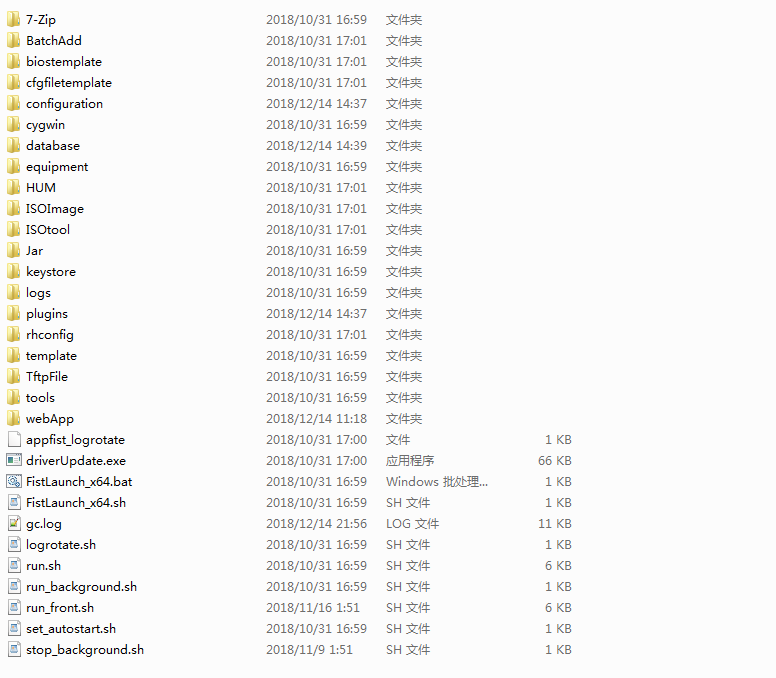
2.Double-click the FistLaunch_x64.bat file.
The UniSystem console opens a few seconds later.
3.Verify the following UniSystem connection settings:
HTTP Port: HTTP service port number of UniSystem. The value range is 1 to 65535. By default, HTTP port 80 is used for login. Make sure the specified port number is not used by another service.
HTTPS Port: HTTPS service port number of UniSystem. The value range is 1 to 65535. Make sure the specified port number is not used by another service.
Session Timeout: Session timeout time in seconds. The value range is 600 to 1800, and the default is 1800.
Front Display: Whether or not to display the UniSystem console always in the foreground.

4.Click START.
5.Click Details to view the UniSystem startup progress and verify that it is started correctly.
Figure 4 Viewing UniSystem startup details
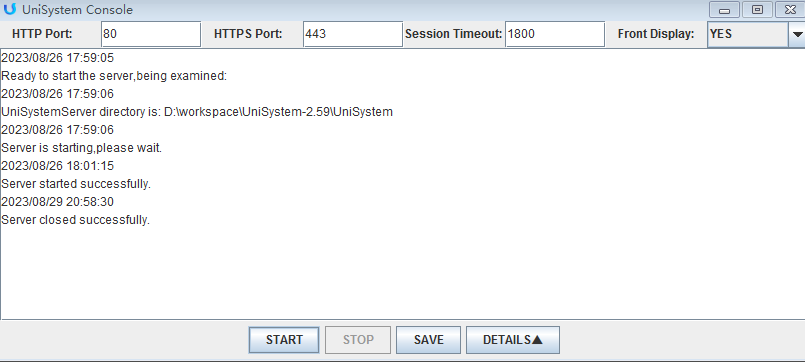
Updating UniSystem on a Linux server by using the .tar installation package
You must have root privileges to perform this task.
After installation, you can run UniSystem on the server by using an account with administrative privileges.
Updating and starting UniSystem from the GUI
1.Download the UniSystem installation package (AppFist-1.00.04.tar.gz, in this example), and then save the package to the Linux server. This examples save the package to the root directory of the Linux server.
2.Open the terminal window.
3.Enter tar -xf AppFist–1.00.04.tar.gz, and then press Enter to decompress the installation package.
Figure 5 Decompressing the UniSystem installation package

4.Enter cd AppFist/ to open the AppFist folder.
Figure 6 Opening the AppFist folder

5.Enter bash FistLaunch_x64.sh, and then press Enter to launch the UniSystem console window.
6.Verify the following UniSystem connection settings:
HTTP Port: HTTP service port number of UniSystem. The value range is 1 to 65535, and default is 80. Make sure the specified port number is not used by another service.
HTTPS Port: HTTPS service port number of UniSystem. The value range is 1 to 65535, and default is 443. Make sure the specified port number is not used by another service.
Session Timeout: Session timeout time in seconds. The value range is 600 to 1800, and the default is 1800.
Front Display: Whether or not to display the UniSystem console always in the foreground.
Figure 7 UniSystem console

7.Click START.
IMPORTANT: Keep the UniSystem console window open while UniSystem is running. Closing the window will interrupt the UniSystem service. |
8.Click Details to view the UniSystem startup progress and verify that it is started correctly.
Figure 8 Viewing UniSystem startup details
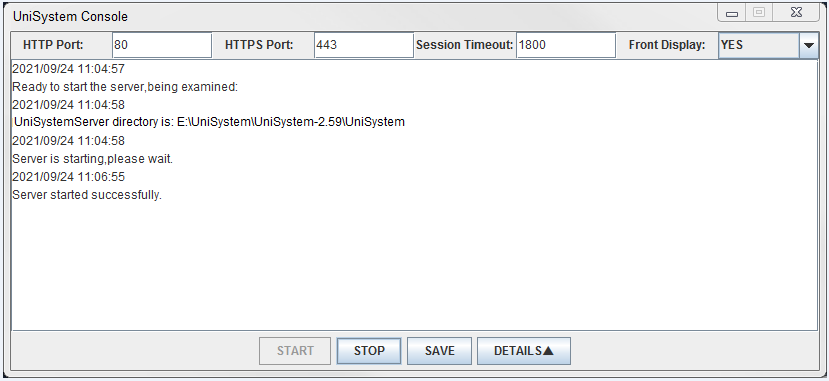
Updating and starting UniSystem from the CLI
1.Download the UniSystem installation package (AppFist-1.00.04.tar.gz, in this example), and then save the package to the root directory of the Linux server.
2.Enter tar -xf AppFist–1.00.04.tar.gz, and then press Enter to decompress the installation package.
Figure 9 Decompressing the UniSystem installation package

3.Enter cd AppFist/ to open the AppFist folder.
Figure 10 Opening the AppFist folder

IMPORTANT: Do not start multiple UniSystem processes on the same server. Doing so might cause UniSystem startup failures. |
4.Enter ./run.sh 80 443 1800 to start UniSystem.
The values 80 and 443 are the default HTTP and HTTPS port numbers of UniSystem, both of which can be changed to a value in the range of 1 to 65535.
The value 1800 is the default session timeout time, which can be changed to a value in the range of 600 to 1800, in seconds.
Figure 11 Running UniSystem

Updating and starting UniSystem by using the ISO image
UniSystem provides an ISO image file which allows you to install a UI-equipped H3C Linux 1.1.2 system with the UniSystem software embedded. You can mount the ISO image to the target server and then have the server boot to the image to start the installation process. No further manual intervention is required. UniSystem automatically runs in the background upon completion of the Linux installation.
The AE module comes with UniSystem preinstalled. You can use the ISO image to update the UniSystem module in an AE module. For information about how to mount the ISO image, see H3C Servers Operating Systems Installation Guide.
The following information describes the procedure for using the ISO image to update UniSystem in an AE module.
1.Launch the HDM KVM console of the AE module.
2.Select Media > Virtual Media Wizard from the top menu bar.
The Virtual Media window opens.
Figure 12 Virtual Media window
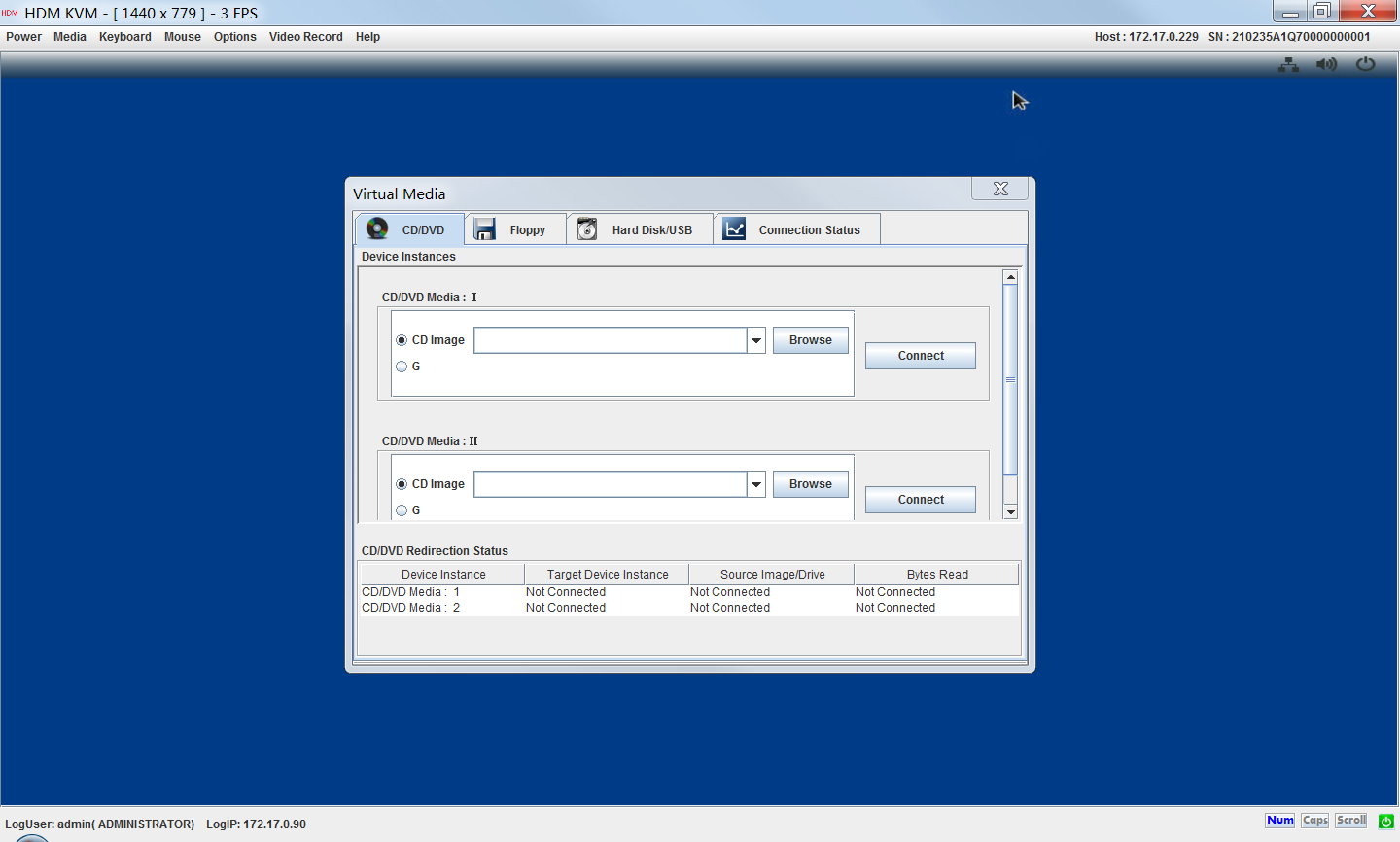
3.On the CD/DVD tab, click Browse next to a CD Image field to select the ISO image file, and then click Open.
4.Click Connect.
Figure 13 ISO image file mounted
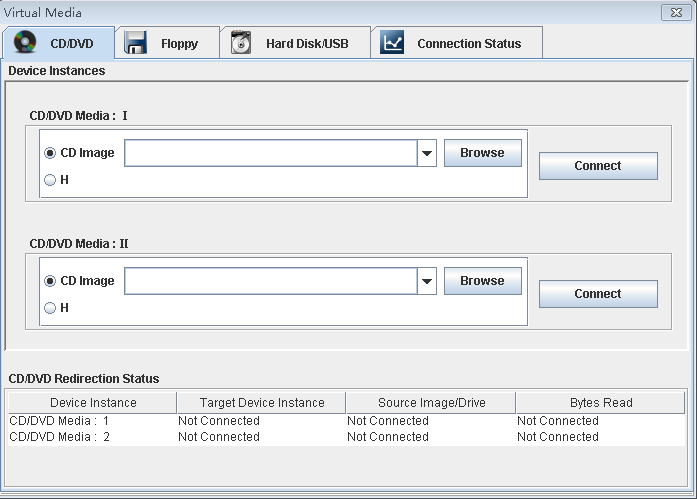
5.Reboot the server. The server automatically enters the virtual CDROM boot option.
6.The system starts to install UniSystem. The process takes about 30 minutes and does not require manual intervention.
Figure 14 Installing UniSystem
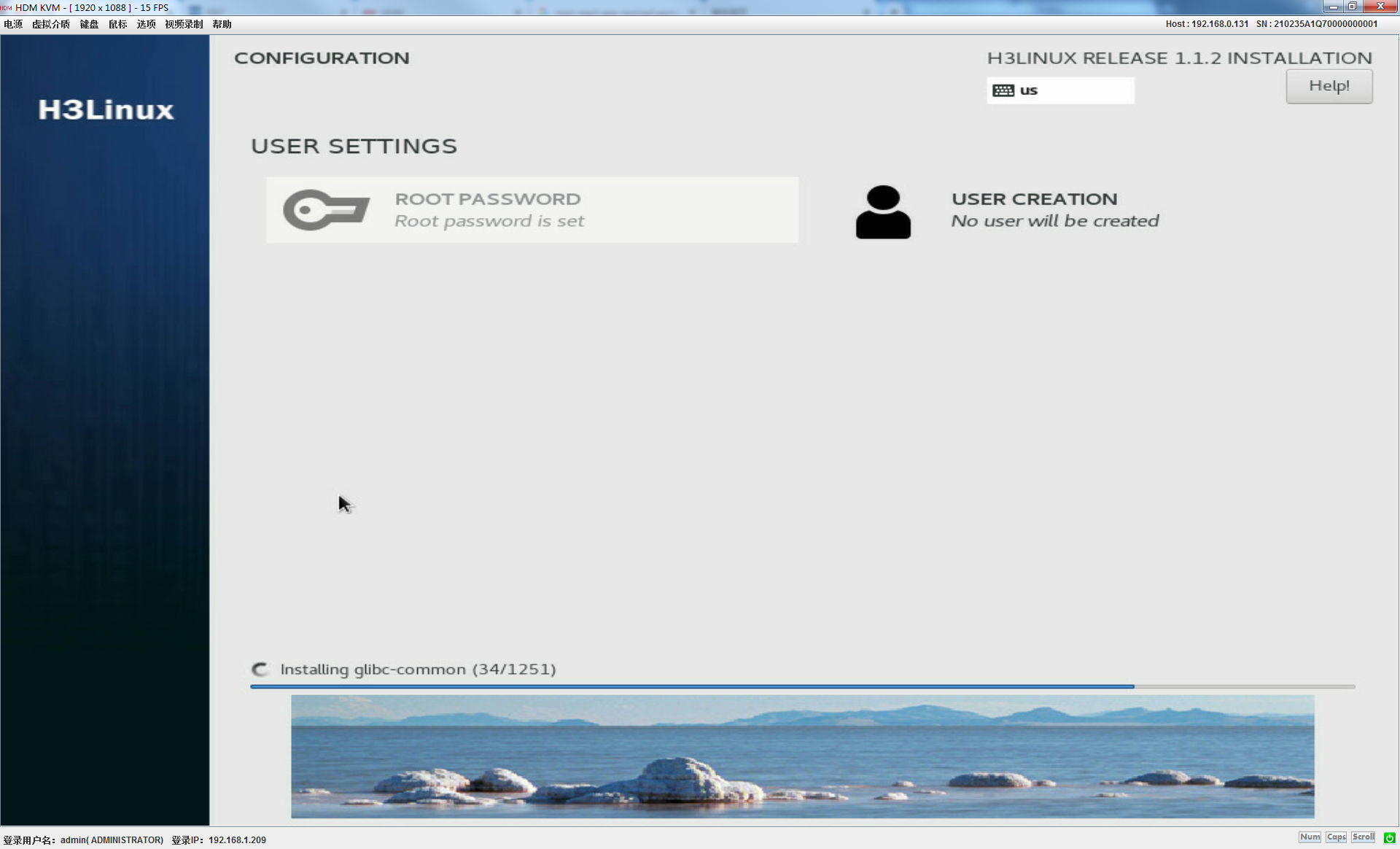
7.After the installation is complete, UniSystem automatically starts to run in the background.
Incorporating UniSystem to vCenter Server as a UniSystem plugin
| NOTE: This feature is supported only when UniSystem runs on a PC, AE module, or virtual machine environment. |
About this feature
You can incorporate UniSystem as a plugin to vCenter Server. After that, you can access UniSystem through vSphere Client, an application that allows you to directly connect to a vCenter Server instance.
Prerequisites
Obtain the IP address, login username, and password of the vCenter Server.
Procedure
1.Enter https://UniSystem ip address:https port in the address bar to log in to UniSystem. Then, enter https://UniSystem ip address:https port/server/0/register-plugin in the address bar to access the Register Plugin page.
IMPORTANT: To ensure normal access to UniSystem after UniSystem plugin registration, log in to UniSystem through HTTPS. |
Figure 15 Accessing the Register Plugin page
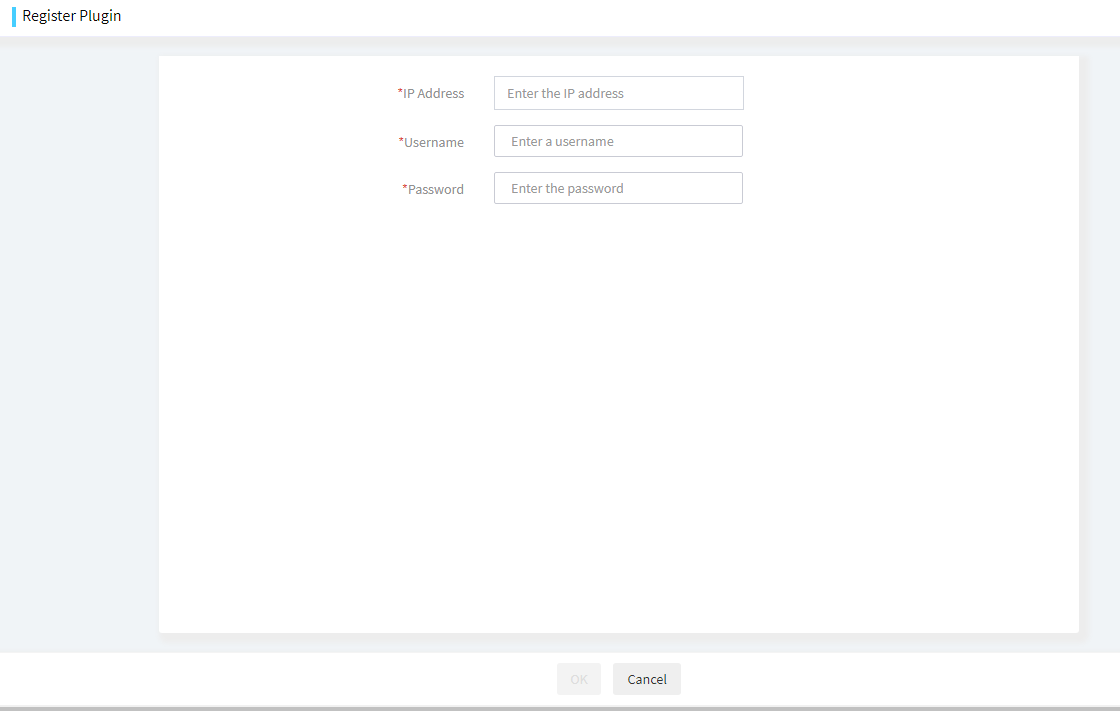
2.Enter the IP address, username, and password of vCenter Server, and then click OK.
3.After the registration is complete, log in to vSphere Client. Click the UniSystem icon on the Shortcuts page to access UniSystem through vSphere Client.
Restrictions and guidelines
If the UniSystem installation screen might turn black, because KVM fails to process data in time due to high network traffic. To resolve this issue, check your local PC's connection speed and duplex mode, and configure the settings or set automatic detection accordingly as follows:
1.Select Network and Internet.
2.Select Network Connections, and choose the network in use.
3.Select Properties, click Configure > Advanced, select Speed & Duplex in the property list, and then set Value to Auto Negotiation.
Handling firmware update failures
If the UniSystem firmware update fails, the system starts up with the original firmware version.
To resolve the firmware update failure issue:
1.Verify that a root user account is used to perform the firmware update operation.
2.Verify that the firmware image file is not corrupted.
Deleting the browsing history in Internet Explorer
1.Click the Tools icon, and then select Internet options from the menu that opens.
Figure 16 Tools menu
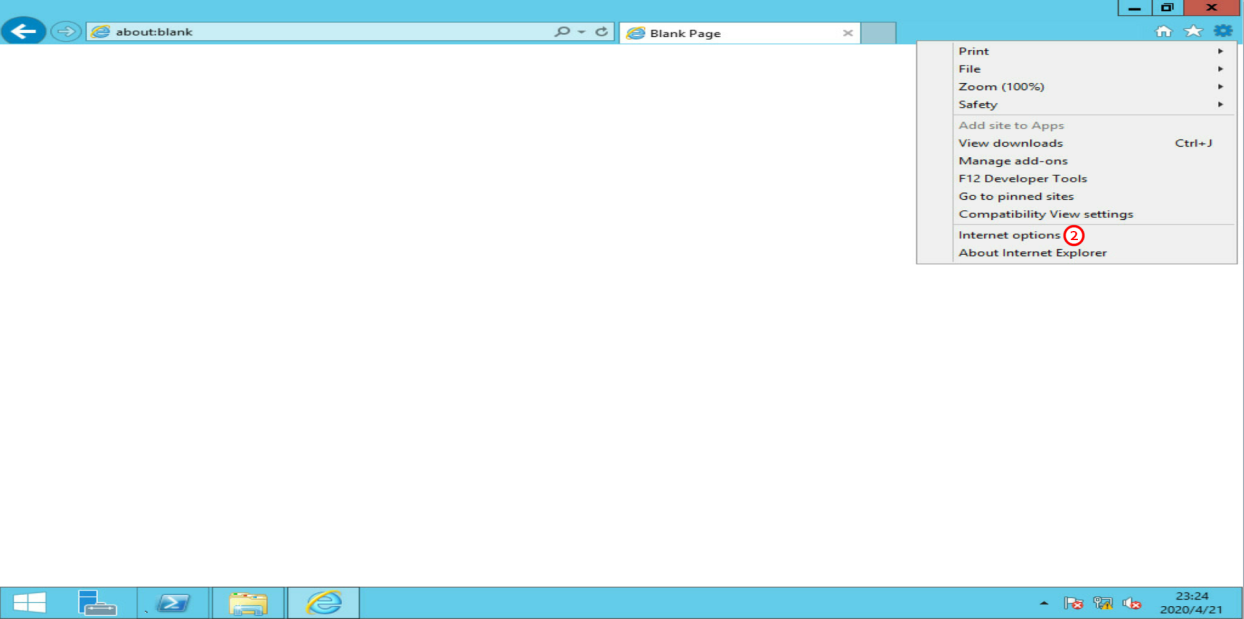
2.Click Delete….
Figure 17 Internet options
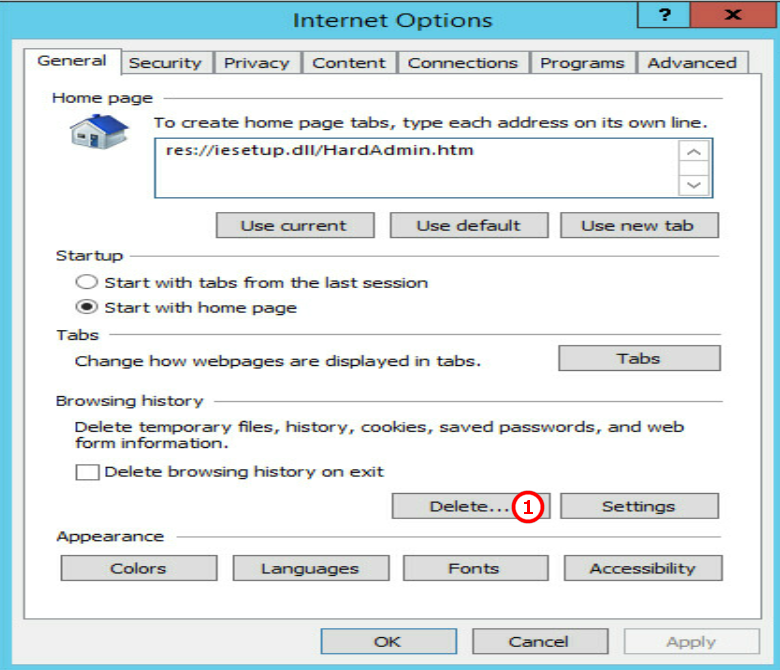
3.In the Delete Browsing History window, click Delete.
Figure 18 Deleting the browsing history
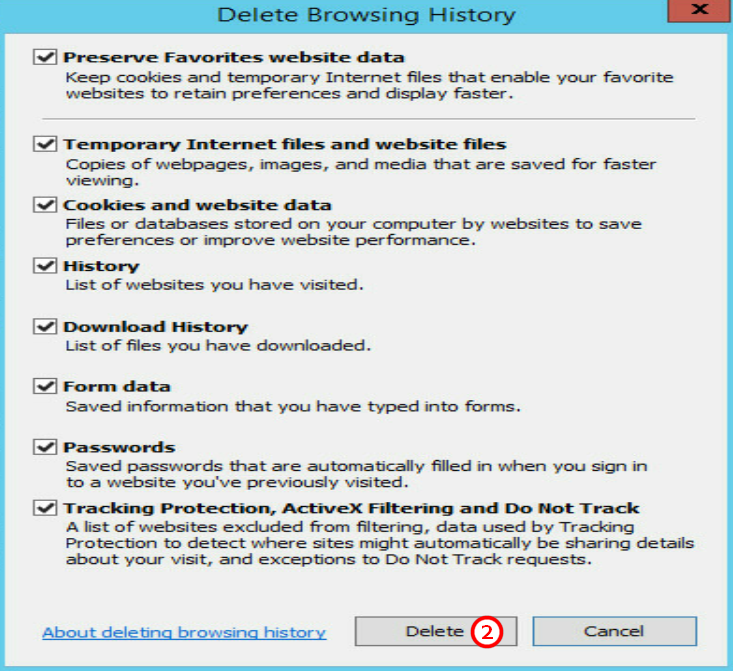
Deleting the browsing history in Firefox
1.Click the Open menu icon, and then select Options from the menu that opens.
Figure 19 Menu options
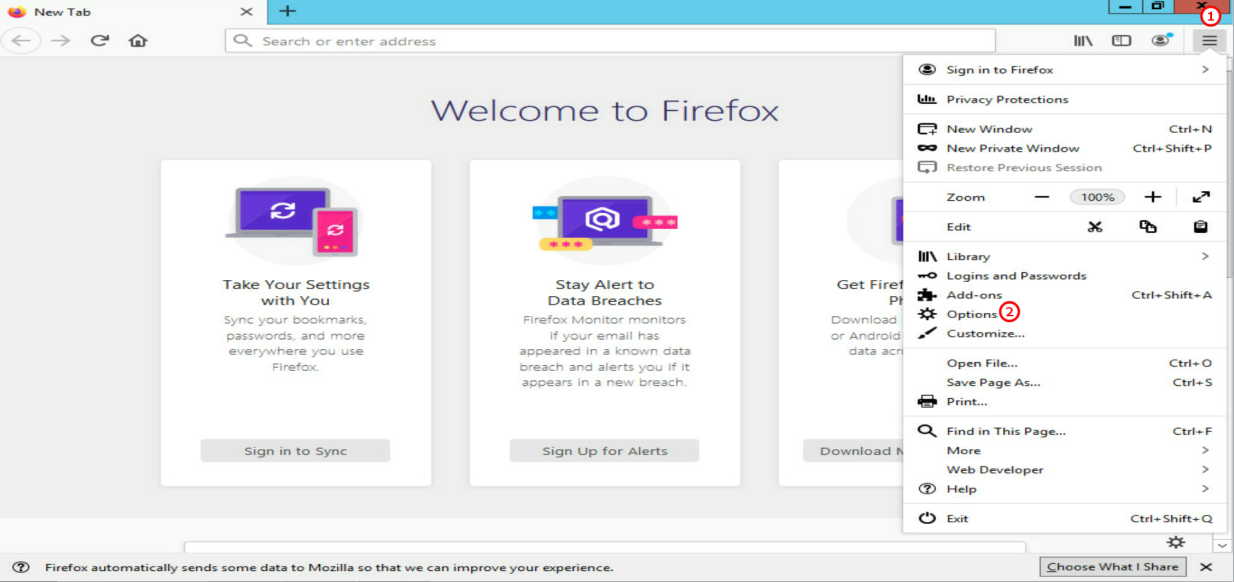
2.In the left navigation pane, select Privacy & Security, and then select Clear History…
Figure 20 Privacy & Security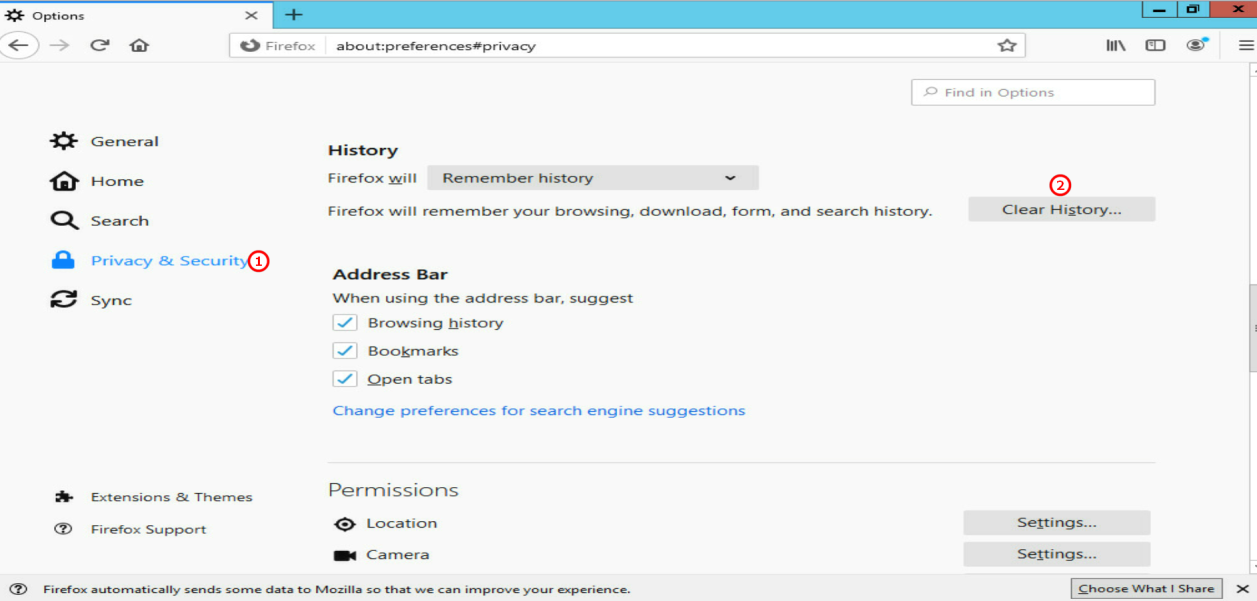
3.Click Clear Now.
Figure 21 Clearing history now
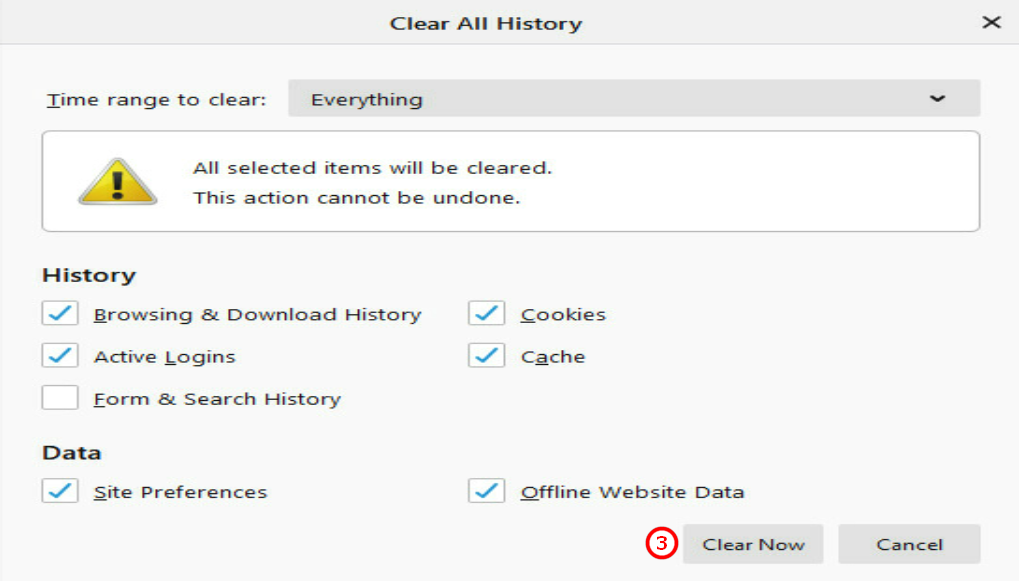
Deleting the browsing history in Chrome
1.Click the Customize and control Google Chrome menu icon, and then select History from the menu that opens.
Figure 22 Customize and control Google Chrome menu
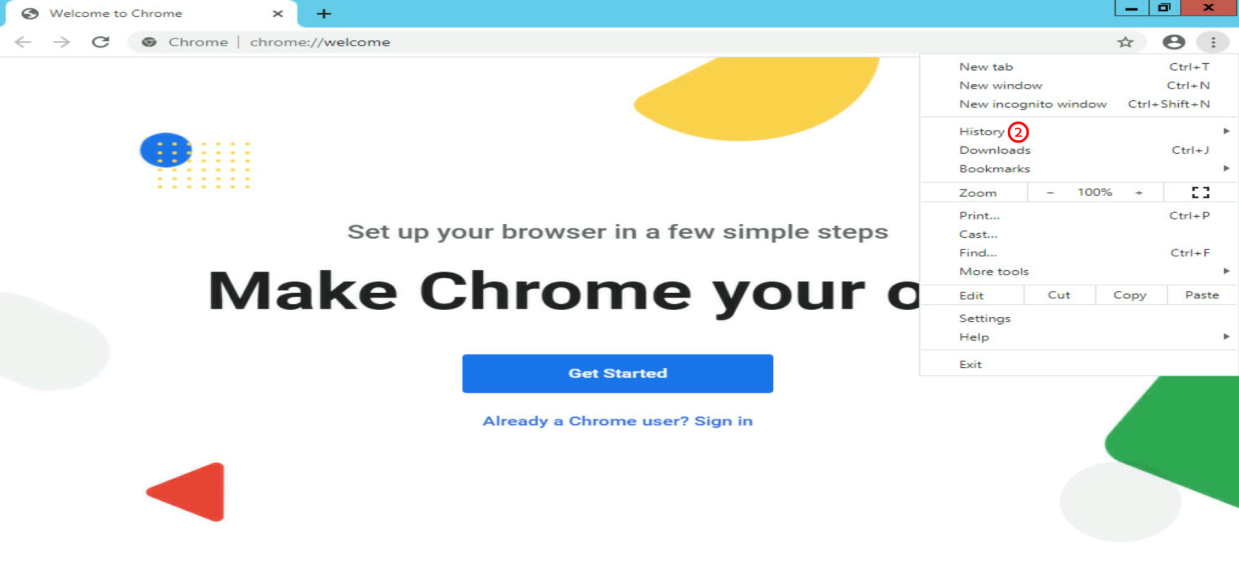
2.Click Clear data….
Figure 23 Clearing browsing data
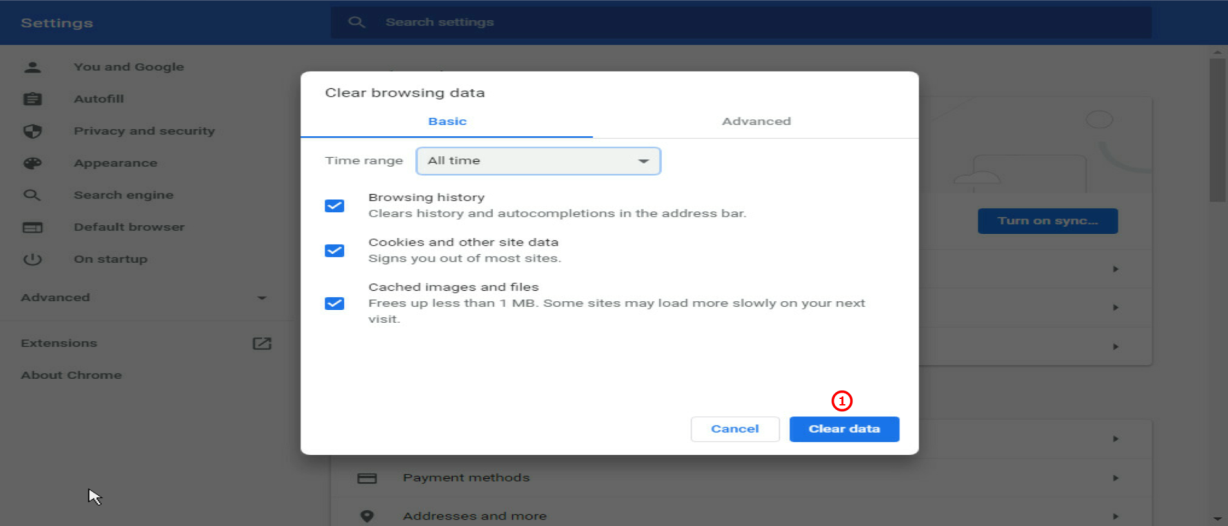
Appendix C Upgrading UniSystem software by using the upgrade package
This feature allows you to upgrade or downgrade the UniSystem software version. UniSystem software upgrade will not cause UniSystem data loss. However, as a best practice, back up the critical data before upgrading UniSystem.
The UniSystem upgrade interface is available only for UniSystem running on a VM or AE module. UniSystem of the package version does not need installation. To upgrade UniSystem of the package version, replace the new package with the old package.
To ensure that UniSystem can be upgraded normally, first stop the other UniSystem operations in progress before upgrading UniSystem.
Upgrading UniSystem will log out all logged-in users except the current user. Additionally, other users cannot log in during the UniSystem upgrade process.
Upgrading UniSystem will interrupt or restart related processes in the system where UniSystem is installed. If these processes are being used, related services might be interrupted.
Procedure (for UniSystem on a VM or AE module)
4.In the navigation pane, select Menu > System > Maintain and Upgrade. Click the UniSystem Software Upgrade tab.
Figure 24 UniSystem Software Upgrade page
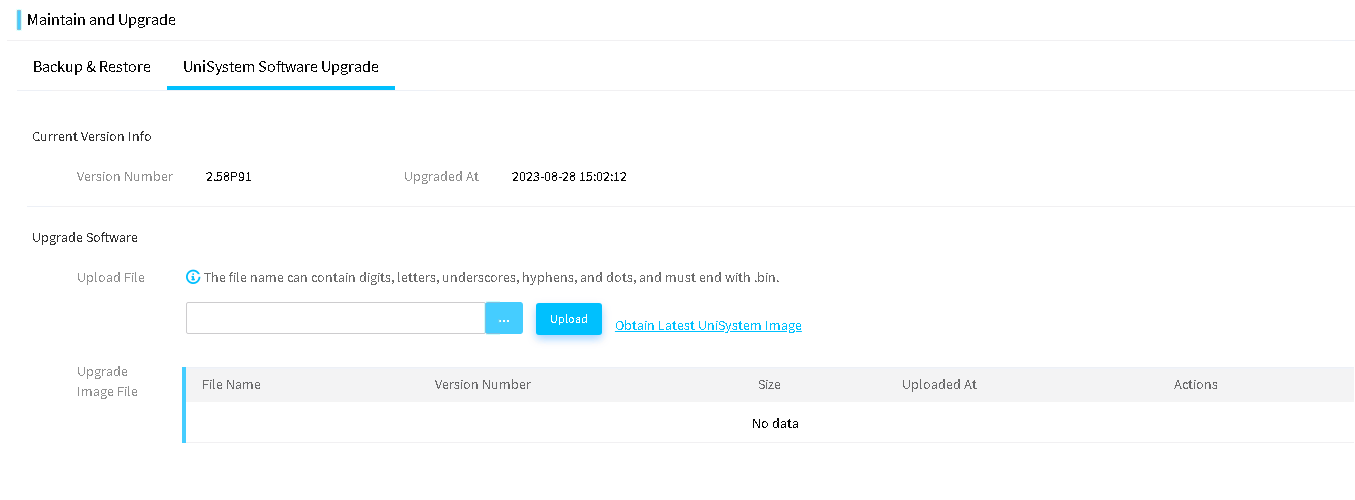
5.(Optional.) Click Obtain Latest UniSystem Image to download the needed UniSystem software upgrade package from the official website.
6.Click the … button for the software upgrade operation, select the UniSystem upgrade package, and click Upload to upload the upgrade package.
7.Click Start Upgrade. In the dialog box that opens, click OK to start upgrading UniSystem.
After the upgrade is finished, UniSystem will automatically restart and return to the login page. After UniSystem is restarted, refresh the page, and log in to use the new UniSystem version.
Procedure (for UniSystem of the package version)
IMPORTANT: After the upgrade, the port configuration cannot be retained. |
8.Obtain the UniSystem upgrade package from the official website, and then click STOP to stop UniSystem, as shown in Figure 24.
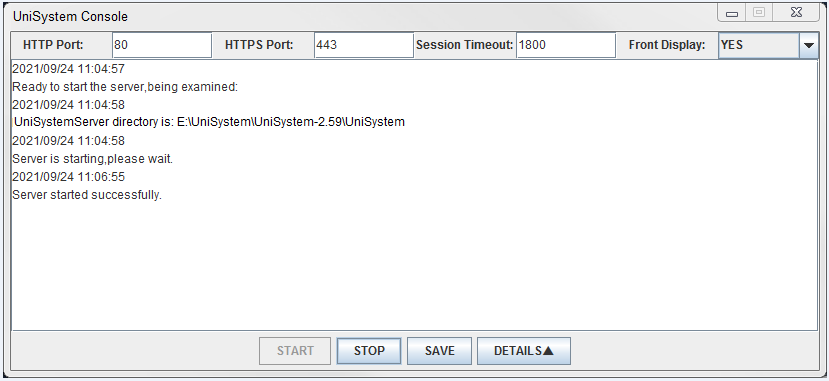
9.Select the new UniSystem upgrade package, decompress the package, and override the original UniSystem directory. Then, choose to replace all files as instructed, as shown in Figure 25.
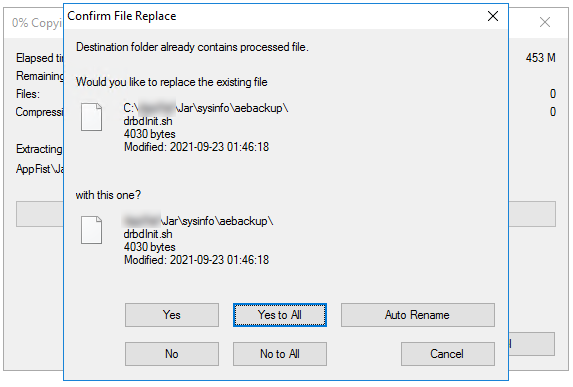
10.Restart UniSystem.

